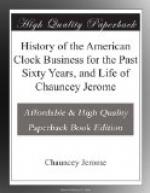I have said that when I got up this one day brass clock in 1838, that the fourth chapter in the Yankee clock business had commenced. Perhaps Seth Thomas hated as bad as any one did to change his whole business of clock making for the second time, and adopt the same thing that I had introduced. He never invented any thing new, and would now probably have been making the same old hang-up wood clocks of fifty years ago, had it not been for others and their improvements. He was highly incensed at me because I was the means of his having to change. He hired a man to go around to my customers and offer his clocks at fifty and seventy-five cents less than I was selling. A man by the name of J.C. Brown carried on the business in Bristol a long time, and made a good many fine clocks, but finally gave up the business. Elisha Monross, Smith & Goodrich, Brewster & Ingraham were all in the same business, but have given it up, and the clock making of Connecticut is now mostly done in five large factories in different parts of the State, about which I shall speak hereafter.
CHAPTER VIII.
Further improvements in cheap time-keepers.
—The process of clock
making.—
It would be no doubt interesting to a great many to know what improvements have been made in manufacturing clocks during the past twenty years. I recollect I paid for work on the O.G. case one dollar and seventy-five cents; for the same work in 1855, I paid twenty cents, and many other things in the same proportion. The last thing that I invented, which has proved to be of great usefulness, was the one day timepiece that can be sold for seventy-five cents, and a fair




